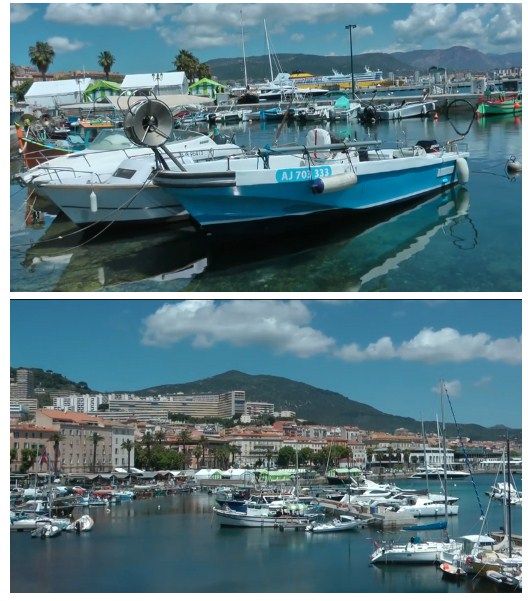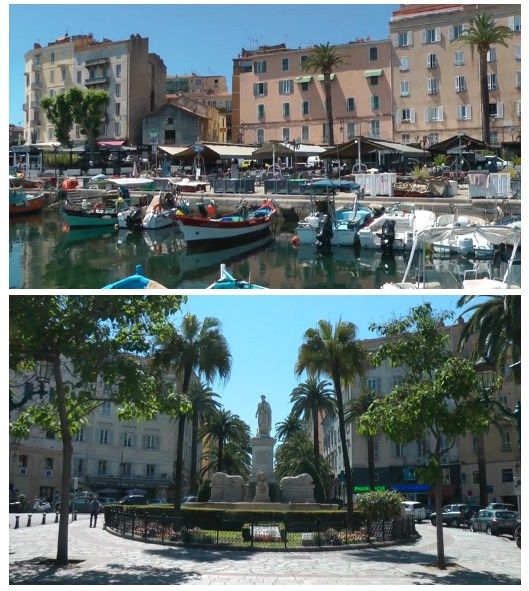
City of Art and History and the first city to be liberated in France during the Second World War, Ajaccio is one of the jewels of the Island of Beauty in Corsica.
An ancient imperial city, it is located in the south of the island on the shores of the Mediterranean Sea.
Very ancient, the town of Ajaccio experienced its first development in antiquity, around the 2nd century BC, but it was especially in the 15th century that it really took off with the arrival of the Genoese. They completely rebuilt this city, which was then abandoned.
It then passed under the umbrella of France and became the main town of the island's only department under Napoleon I, where it originated. Popular with world leaders in the 19th century, the Corsican city is today a popular tourist spot.

It is no coincidence that, with a third of its natural heritage protected, Corsica is called the Island of Beauty or the Pearl of the Mediterranean.
It has more than 1,000 kilometres of coastline with waters so crystal clear and blue that it is hard to believe. You have to visit it and visit it.
Its geography ranges from rugged cliffs in the north to gentle beaches in the south.
Napoleon's city.

The most important monuments are the Imperial Chapel, the Cathedral, the Museum of Fine Arts also known as Palazzo Fesch, Marshal Foch Square, the Town Hall, the birthplace of Napoleon Bonaparte and the Citadel.
The renovation of the Museum of Fine Arts has resulted in a surface area of more than 2,000 m2.
The Museum presents a broad panorama of Italian painting and is considered the second largest French collection after the Louvre Museum.

The birthplace of Napoleon Bonaparte is the only National Museum on the island of Corsica.
Located in the heart of ‘old’ Ajaccio, it is the symbol of the Bonapartist government and has a beautiful garden.
Every year in August, the Napoleonic Days take place with parades, parades, changing of the guard, procession and theatre. Three days dedicated to the celebration of the illustrious citizen of Ajaccio.
Crossing the inner streets of the city, authentic alleys where vehicular traffic is forbidden, you can discover open-air markets of regional products, a classic of the historic centres of most European cities.
Shopping at night.

Every Friday in July and August, it is possible to go shopping in the evening, which gives Ajaccio a particularity with the opening of commercial activities in the historic centre and musical and theatrical animations in the streets of the city.
The Sanguinary Islands.

You can also visit the Sanguinary Islands as they are only 7 km away from the city centre of Ajaccio.
You can go there on foot, but you can also go by car, bus or train.
The name has no sinister meaning but is due to the colour of the sunset, where according to ancient legends, it seems to be tinged with a blood red colour that is reflected in the red porphyry rocks.
This small archipelago is made up of five islands (Mezzu Mare with the 15-metre high lighthouse, Cormorans, Cala d'Alga, Porri and U Sbiru which is actually a rock) plus a housing estate called Punta de la Parata dominated by a Genoese-built tower. in 1608.
SEPARADOR
Ciudad de Arte e Historia y primera ciudad liberada en Francia durante la Segunda Guerra Mundial, Ajaccio es una de las joyas de la Isla de la Belleza, en Córcega.
Antigua ciudad imperial, que se desarrolla en el sur de la isla a orillas del mar Mediterráneo.
Muy antiguo, el municipio de Ajaccio experimentó su primer desarrollo en la antigüedad, alrededor del siglo II a. C., pero fue sobre todo en el siglo XV cuando realmente despegó con la llegada de los genoveses. Reconstruyeron completamente esta ciudad, que luego quedó abandonada.
Luego pasó bajo el paraguas de Francia y se convirtió en la ciudad principal del único departamento de la isla bajo las órdenes de Napoleón I, de donde era originaria. Un lugar popular entre los líderes mundiales en el siglo XIX, la ciudad corsa es hoy un lugar turístico muy popular.

No es casualidad que, con un tercio de su patrimonio natural protegido, Córcega sea llamada la Isla de la Belleza o la Perla del Mediterráneo.
Tiene más de 1.000 kilómetros de costa con aguas tan cristalinas y azules que cuesta creerlo. Hay que visitarlo y visitarlo.
Su geografía abarca desde escarpados acantilados en el norte hasta suaves playas en el sur.
La ciudad de Napoleón.

Los monumentos más importantes son la Capilla Imperial, la Catedral, el Museo de Bellas Artes también conocido como Palazzo Fesch, la Plaza Mariscal Foch, el Ayuntamiento, la casa natal de Napoleón Bonaparte y la Ciudadela.
La renovación del Museo de Bellas Artes ha llevado a que actualmente cuente con una superficie superior a los 2.000 m2.
El Museo presenta un amplio panorama de la pintura italiana y está considerado la segunda colección francesa más grande después del Museo del Louvre.
El lugar de nacimiento de Napoleón Bonaparte es el único Museo Nacional de la isla de Córcega.

Situado en el corazón del "viejo" Ajaccio, es el símbolo del gobierno bonapartista y tiene un hermoso jardín.
En el mes de agosto de cada año tienen lugar las Jornadas Napoleónicas con desfiles, paradas, cambio de guardia, cortejo y teatro. Tres días dedicados a la celebración del ilustre ciudadano de Ajaccio.
Atravesando las calles internas de la ciudad, auténticos callejones donde está prohibido el tráfico de vehículos, podemos descubrir mercados al aire libre de productos regionales, un clásico de los centros históricos de la mayoría de las ciudades europeas.
Compras nocturnas.

Todos los viernes de julio y agosto es posible ir de compras por la noche, lo que da a Ajaccio una particularidad con la apertura nocturna de actividades comerciales en el centro histórico y animaciones musicales y teatrales en las calles de la ciudad.
Las Islas Sanguinarias.

También puedes visitar las Islas Sanguinarias ya que están a sólo 7 km del centro de la ciudad de Ajaccio.
Puedes ir a pie, pero también puedes hacerlo en coche, autobús o tren.
El nombre no tiene ningún significado siniestro sino que se debe al color del atardecer, donde según antiguas leyendas, parece teñirse de un color rojo sangre que se refleja en las rocas de pórfido rojo.
Este pequeño archipiélago está formado por cinco islas (Mezzu Mare con el faro de 15 metros de altura, Cormorans, Cala d'Alga, Porri y U Sbiru que en realidad es una roca) más una urbanización llamada Punta de la Parata dominada por una torre de construcción genovesa. en 1608.

Source images / Fuente imágenes

Upvoted. Thank You for sending some of your rewards to @null. Get more BLURT:
@ mariuszkarowski/how-to-get-automatic-upvote-from-my-accounts@ blurtbooster/blurt-booster-introduction-rules-and-guidelines-1699999662965@ nalexadre/blurt-nexus-creating-an-affiliate-account-1700008765859@ kryptodenno - win BLURT POWER delegationNote: This bot will not vote on AI-generated content
Thanks!